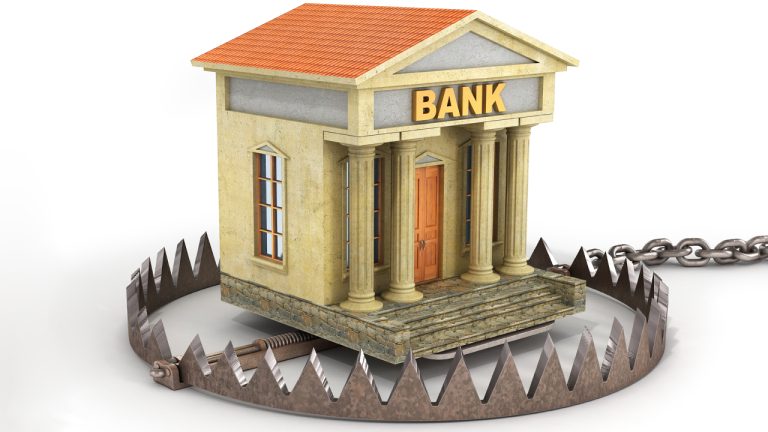 Justin Bons, founder and CIO of Cybercapital, a European cryptocurrency fund, alerted about the vulnerability of smaller parties in the case of a bitcoin bank run. A price drop event would trigger the hypothetical event, forcing miners to shut down their operations due to unprofitability and affecting network operativity. Cybercapital CIO Justin Bons Alerts About […]
Justin Bons, founder and CIO of Cybercapital, a European cryptocurrency fund, alerted about the vulnerability of smaller parties in the case of a bitcoin bank run. A price drop event would trigger the hypothetical event, forcing miners to shut down their operations due to unprofitability and affecting network operativity. Cybercapital CIO Justin Bons Alerts About […]
Chinese authorities are moving to prevent further financial contagion as a bank run unfolds in one of its provinces. Thousands of customers lined up to withdraw their money amid worries the Bank of Cangzhou is at risk of going under, CNN reports, citing state-run Chinese media. The regional bank lent hundreds of millions of dollars […]
The post Financial Fears Trigger Bank Run in China As Officials Push To Prevent Contagion: Report appeared first on The Daily Hodl.
 Interest in the U.S. banking crisis has risen greatly over the past two weeks, as shown by Google Trends data. There has been a sharp increase in queries related to search terms such as “banking crisis,” “bank collapse,” and “bank failure.” On March 13, 2023, the search term “banking crisis” reached the top Google Trends […]
Interest in the U.S. banking crisis has risen greatly over the past two weeks, as shown by Google Trends data. There has been a sharp increase in queries related to search terms such as “banking crisis,” “bank collapse,” and “bank failure.” On March 13, 2023, the search term “banking crisis” reached the top Google Trends […]
Former PayPal executive, tech investor and entrepreneur David Sacks says another bank run is already underway at a second regional bank following the abrupt collapse of Silicon Valley Bank. In a new interview with UnHerd, Sacks says he knows of at least one other bank that is already facing mass withdrawals from corporate clients. “I […]
The post New Bank Run Already Underway at Second Regional Bank After SVB Collapse, Says Investor David Sacks appeared first on The Daily Hodl.
 After U.S. regulators shut down Silicon Valley Bank (SVB) on Friday, the Bank of England has closed the company’s U.K.-based arm. The central bank explained that it intends to place the subsidiary into bank insolvency procedures. Fallout From SVB Failure Prompts BOE to Close U.K. Branch The ripple effect of the 16th largest bank in […]
After U.S. regulators shut down Silicon Valley Bank (SVB) on Friday, the Bank of England has closed the company’s U.K.-based arm. The central bank explained that it intends to place the subsidiary into bank insolvency procedures. Fallout From SVB Failure Prompts BOE to Close U.K. Branch The ripple effect of the 16th largest bank in […] Silicon Valley Bank (SVB) has become the center of attention after its collapse prompted the U.S. Federal Deposit Insurance Corporation (FDIC) to shut the bank down on Friday. It was the largest U.S. bank failure since 2008, and various alleged catalysts have been pointed to. Some believe venture capitalists caused a bank run, while others […]
Silicon Valley Bank (SVB) has become the center of attention after its collapse prompted the U.S. Federal Deposit Insurance Corporation (FDIC) to shut the bank down on Friday. It was the largest U.S. bank failure since 2008, and various alleged catalysts have been pointed to. Some believe venture capitalists caused a bank run, while others […] After Silicon Valley Bank (SVB) experienced financial turmoil, the U.S. Federal Deposit Insurance Corporation (FDIC) and the California Department of Financial Protection and Innovation closed the financial institution. Insured depositors can withdraw their funds on Monday after the FDIC took over the failed bank. Federally Insured Depositors to Withdraw Funds on Monday, Uncertainty Looms for […]
After Silicon Valley Bank (SVB) experienced financial turmoil, the U.S. Federal Deposit Insurance Corporation (FDIC) and the California Department of Financial Protection and Innovation closed the financial institution. Insured depositors can withdraw their funds on Monday after the FDIC took over the failed bank. Federally Insured Depositors to Withdraw Funds on Monday, Uncertainty Looms for […]
Net outflows at the cryptocurrency exchange hit $788 million over the last 24 hours, however, Binance told Cointelegraph that “Funds are SAFU.”
Cryptocurrency exchange Binance has seen a surge of withdrawals over the last 24 hours as investors appear to be spooked over recent news of regulatory action against Paxos and its stablecoin Binance USD (BUSD).
At the same time, the BUSD token has recorded significant redemptions, with 342 million BUSD burned over the last 24 hours according to Peckshield.
#PeckShieldAlert ~342M $BUSD have been burned at Paxos Treasury within the last 24 hours, $BUSD MarketCap: $15.8Bhttps://t.co/BMeVokqVE6 pic.twitter.com/hJdnixxbtD
— PeckShieldAlert (@PeckShieldAlert) February 14, 2023
On Feb. 12, news broke that the United States Securities and Exchange Commission gave notice of potential enforcement action against Paxos. It alleged the stablecoin is an unregistered security, an assertion that Paxos denies.
Data compiled from the blockchain intelligence platform Nansen show that Binance recorded 24-hour multichain token net outflows of $788.5 million, caused by outflows of $2.7 billion exceeding inflows of around $1.97 billion.
According to Dune analytics data, it’s the largest 24-hour net outflow since Dec. 17, when Binance’s proof-of-reserve audits were removed from auditor Mazars’ website.
A spokesperson for Binance told Cointelegraph that “funds are SAFU” — backed by a Secure Asset Fund for Users — echoing what Binance chief Changpeng “CZ” Zhao said earlier on Feb. 13.
The spokesperson added that the exchange recently had a sell-off with “more than $1 billion” withdrawn in a 12-hour period, which it claims “was managed with ease.”
“We run a very simple business model — hold assets in custody and generate revenue from transaction fees,” Binance said, adding:
“We take our responsibility as a custodian seriously and maintain 1:1 backing for every user asset.”
Following the SEC’s action and a reported tip-off from USD Coin (USDC) issuer Circle, the New York Department of Financial Services (NYDFS) ordered Paxos to halt the issuance of BUSD on Feb. 13.
Related: Are stablecoins securities? Well, it’s not so simple, say lawyers
The outflows and token burns seemingly are a response to those events, with crypto users cashing out of the stablecoin over fears of further regulatory action.
Binance’s reserves harbor the largest amount of BUSD, holding $14.4 billion worth of the stablecoin, or around 90% of the $16.1 billion current market cap.
The crypto exchange also has around $60 billion worth of reserves, with 22% of that made up of BUSD.

CoinList blamed “custodian issues” with one suffering an outage affecting “many tokens” on the platform as the reason for reported withdrawal problems.
Cryptocurrency exchange and Initial Coin Offering (ICO) platform CoinList took to Twitter to address “FUD” after a blogger tweeted that users reported being unable to withdraw funds for over a week, sparking fears the company was having liquidity issues or w insolvent.
“There is a lot of FUD going around that we would like to address head-on,” CoinList said in a Nov. 24 Twitter thread that stated the exchange is “not insolvent, illiquid, or near bankruptcy.” It said however that its deposits and withdrawals are affected by “technical issues.”
2/ We are upgrading our internal ledger systems and are migrating wallet addresses involving multiple custodians.
— CoinList (@CoinList) November 24, 2022
This is one of many efforts we are undertaking to offer our customers around the world better products and services while maintaining compliance.
Crypto-focused blogger Colin Wu had earlier tweeted to his 245,000 followers that “some community members” using CoinList have been unable to withdraw for over a week due to maintenance.
CoinList has a $35 million creditor claim with bankrupt crypto hedge fund Three Arrows Capital which Wu said in his tweet was a “loss,” that likely triggered concerns the company was insolvent or illiquid.
Looking to dampen fears that have seen bank runs on other platforms, CoinList explained that an upgrade to its internal systems and a migration of wallet addresses that involves “multiple custodians” is being undertaken.
The company cited unexplained “custodian issues” as the reason a selection of cryptocurrencies “are taking longer than anticipated to migrate” with one of its unnamed custodian partners suffering from an “outage [...] unrelated to the migration” on Nov. 23 which impacted tokens on the platform.
Its status page shows “degraded performance” for withdrawals, with four cryptocurrencies unavailable for withdrawal since Nov. 15, and one experiencing delayed deposits since Nov. 16.
“Once again, this is purely a technical issue, not a liquidity crunch,” CoinList said. It claimed to hold “all user assets dollar for dollar” and noted it plans to publish its proof of reserves.
Cointelegraph has contacted CoinList for more information but did not immediately receive a response.
Related: FTX illustrated why banks need to take over cryptocurrency
CoinList claimed on Nov. 14 that it had no exposure to the now-bankrupt FTX exchange, but users are increasingly nervous about centralized platforms and have rushed to ensure safe custody of their assets as evidenced by the surge in sales reported in mid-November by hardware wallet providers Trezor and Ledger.
Around the same time, outflows of Bitcoin (BTC) and stablecoins from exchanges hit historic highs and a corresponding uptick in activity was seen on decentralized exchanges.